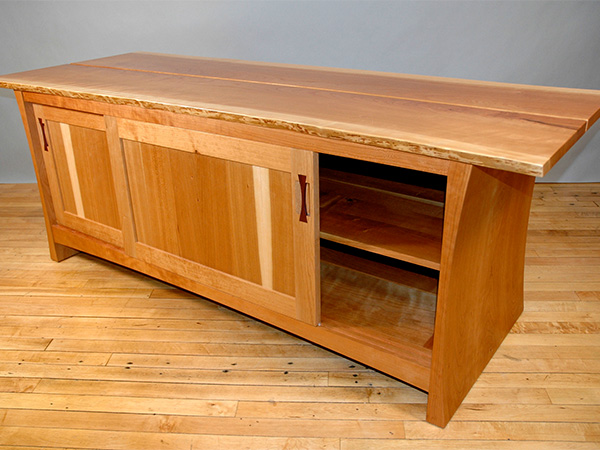
For some of us, a beautiful piece of wood furniture is like a rare and wondrous gem. But for Peter Zuerner, the principal of Zuerner Design in Newport, Rhode Island, the similarity between great wood and gems is more than just metaphor.
Peter makes what he calls simple and elegant furniture and adds facets to the wood as a way to draw attention to the end grain of the wood. It’s become a signature of his work. It all began because he wanted to add some interest to the furniture he designed. He began bringing the legs of different pieces through as a way to emphasize interesting grain. His writing desk is an early example of this technique. Instead of stopping the leg at the skirt, he brings the entire leg through the top of the desk. Then he and his employees go at the end of the legs with a hand chisel, elaborately carving facets into them. And, as it does on gems, this faceting really attracts attention.
This technique, Peter says, “adds a lot of texture to the piece. The legs that come through the top of the desk are faceted, and almost everybody who sits down at it puts their hand right over the leg and has to feel it.”
Customers Who Love Wood
Getting customers to really interact with his furniture is where Peter gets the most satisfaction
from his work. He loves to watch people who really love wood and well designed furniture. It’s especially gratifying to see them light up when they see his work for the first time. “When you find a customer who has a real appreciation for what you’re doing, it makes it so worthwhile and so much more fulfilling,” says Peter.
His only dilemma is that a lot of people who really love his stuff often can’t afford it. That’s why he is designing lines of furniture ? he’s currently working on a bedroom and dining room line ? so he can make multiple copies of the same piece and therefore bring the cost down. Currently, however, most of his work is customized furniture.
The Trouble With Exotics
Peter also prefers to use wood that he can find locally and eschews the exotic hardwoods when he can. “I’m partial to the Northeastern woods: maple, cherry and I’m getting into more walnut,” he says, “I find myself using a lot of exotics just because people like them. I’m not real fond of them.” He is, first off, concerned by the scarcity and harvesting techniques when it comes to the exotics. Some countries are not as careful as they might be in bringing this valuable lumber to market and that worries him.
He’s also not too keen on the toxicity of the sawdust of exotic hardwoods or their abrasive qualities. The stability of exotics is currently on his front burner. He recently built a conference table and sixteen chairs for his old high school out of some jatoba the school already had on hand. He did a lot of research on the Internet about it but didn’t find much information. Now, after the table has been built, the wood seems to be moving a lot and he is concerned that it’s going to be a tough fix.
Peter is also dedicated to creating furniture that will last for generations. He wants, for example, one of his dining room tables to become part of the family, an integral part of a home that will be focal point for family conversations. He doesn’t want his work to be temporary. “I’m not designing for a throwaway society and I don’t wish to,” says Peter.





